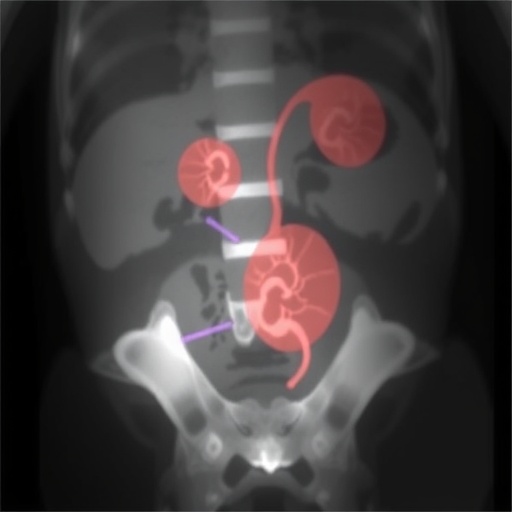The combined results of two ovarian cancer screening trials suggest that a personalized strategy involving frequent screening of high-risk women could improve the chance that tumors are detected at early stages when they are easier to treat. As reported in a paper published in Clinical Cancer Research, these trials imply that a protocol involving quarterly blood test to identify significant increases above each patient's personal baseline in levels of the protein CA125, followed by ultrasound examination when such elevations are detected, could reduce the risk of diagnosis with advanced cancer in high-risk women who choose to delay recommended preventive surgery.
"The standard advice for women at high risk of ovarian cancer, due to either family history or inherited gene mutations, is to have their ovaries and fallopian tubes removed once their families are complete. Some women choose to postpone this surgery," says Steven Skates, PhD, of the Massachusetts General Hospital (MGH) Cancer Center and the Biostatistics Unit, co-lead and corresponding author of the report. "Our screening protocol increased the proportion of tumors detected at early stages from 10 percent – which is typically seen in high-risk women who are not screened – to 50 percent."
CA125 levels are known to be raised over the level of 35 in the blood of most women with ovarian cancer. While screening for raised CA125 and/or transvaginal ultrasound may be considered for high-risk women who postpone surgery, that approach has not been shown to improve patient outcomes.
The two trials reported in the current paper utilize the Risk of Ovarian Cancer Algorithm (ROCA) – co-developed by Skates and Ian Jacobs, MD, FRCOG, of the University of New South Wales in Australia and University College London – which tracks CA125 levels over time to identify significant elevations above each patient's baseline levels, even those that do not exceed the traditional threshold of 35. One trial conducted through the National Cancer Institute's Cancer Genetics Network (CGN) – with additional patients from two ovarian Specialized Programs of Research Excellence (SPORE) and two Early Detection Research Network sites (EDRN) – was led by Skates. The other, conducted through the Gynecologic Oncology Group (GOG), was led by Mark H. Greene, MD, of the Clinical Genetics Branch at the National Cancer Institute (NCI).
Both trials followed similar protocols, enrolling women at elevated risk for ovarian cancer – based on either a strong family history of ovarian and/or breast cancer or the presence in the patient or in close blood relatives of risk-associated mutations in the BRCA1 or BRCA2 genes – who had not yet had risk-reducing surgery. Participants had CA125 blood tests utilizing ROCA every three months, compared with screening for raised CA125 values every 6 or 12 months as in previous screening studies. The investigators calculated a patient's ROCA risk by analyzing the results of each new CA125 test, combined with previous results, and factors such as participant's age and menopausal status.
Women at intermediate ROCA risk were referred for an ultrasound examination, while those at an elevated ROCA risk received both ultrasound and clinical evaluation by either a gynecologic oncologist or the site principal investigator. While the results of those examinations were used to guide decisions about surgical treatment, study participants were free to choose to have their ovaries and fallopian tubes removed at any time during the clinical trials, as is standard practice for women with a BRCA1/2 mutation.
Between 2001 and 2011, the CGN trial enrolled 2,359 women at 25 U.S. sites. The GOG trial enrolled 1,459 women at 112 sites in the U.S. and Australia between 2003 and 2006 and screened them for five years. Among the more than 3,800 participants in both studies, 19 malignant tumors of the ovaries or fallopian tubes were identified during the study periods. Ten cases were diagnosed during screening, and nine were diagnosed by preventive surgery.
Of the ten cases, there was evidence that four were present at the outset of the trial, while six tumors were likely to have developed during the trial period after a CA125 baseline had been measured. While the algorithm can calculate risk without a baseline, ROCA works best when a baseline has been established. The results in these six cases reflect the benefits of a long-term ROCA screening program; all but one were diagnosed by ROCA, giving a sensitivity of over 80 percent ,and 50 percent were detected at early stages.
Another study – the UK Familial Ovarian Cancer Screening Study, led by ROCA co-developer Jacobs and published today in the Journal of Clinical Oncology – found that a similar protocol using ROCA-based testing every four months was also better than current practice at diagnosing early-stage tumors in high-risk women. Skates notes that a formal analysis of the data from all three trials could increase the statistical power of these studies and could lend stronger support to recommending frequent ROCA-based screening for high-risk women who choose to postpone surgery or while waiting for surgery.
While the pattern of cancers detected in these studies supported the potential value of ROCA screening, these studies were not designed to assess whether screening reduced deaths due to ovarian cancer, the authors note. "It is important to note that removal of ovaries and fallopian tubes remains the standard of care when women at increased familial or genetic risk complete their families and reach an age when their risk exceeds that of the general population," stresses Skates, who is an associate professor of Medicine at Harvard Medical School.
Adds Greene, who is a senior principal investigator at the NCI, "Surgery is the primary and best option for reducing the risk of ovarian cancer, and ROCA should only be considered as a promising but unproven option for patients who decide, against medical advice, to postpone their surgery." Both investigators note that further research to identify a greater range of ovarian cancer biomarkers and improved imaging technologies is needed to help detect even more tumors at even earlier stages. Skates is leading a program to discover new biomarkers for early detection of ovarian cancer as part of NCI's Early Detection Research Network.
Skates and Greene are co-lead authors of the Clinical Cancer Research report; and Dianne Finkelstein, PhD, MGH Biostatistics, and Karen Lu, MD, M.D. Anderson Cancer Center, are co-senior authors. Support for the study includes multiple grants from the National Cancer Institute to the Cancer Genetics Network, the Specialized Programs of Research Excellence, and the Early Detection Research Network, and support from the NCI Intramural Research Program.
###
Massachusetts General Hospital has co-licensed software implementing ROCA. Skates is on the scientific advisory board of SISCAPA Assay Technologies, a consultant for Abcodia, and has received a speaker honorarium from Astra-Zeneca.
The NCI Division of Cancer Epidemiology and Genetics (DCEG), home to the Clinical Genetics Branch, is a global leader in cancer epidemiology and genetics research. With its cadre of renowned epidemiologists, geneticists and biostatisticians, DCEG conducts population and multidisciplinary research to discover the genetic and environmental determinants of cancer and new approaches to cancer prevention. The DCG research portfolio informs biological concepts, clinical practice and public health policy.
Massachusetts General Hospital, founded in 1811, is the original and largest teaching hospital of Harvard Medical School. The MGH Research Institute conducts the largest hospital-based research program in the nation, with an annual research budget of more than $800 million and major research centers in HIV/AIDS, cardiovascular research, cancer, computational and integrative biology, cutaneous biology, human genetics, medical imaging, neurodegenerative disorders, regenerative medicine, reproductive biology, systems biology, photomedicine and transplantation biology. The MGH topped the 2015 Nature Index list of health care organizations publishing in leading scientific journals and earned the prestigious 2015 Foster G. McGaw Prize for Excellence in Community Service. In August 2016 the MGH was once again named to the Honor Roll in the U.S. News & World Report list of "America's Best Hospitals."
Media Contact
Katie Marquedant
[email protected]
617-726-0337
@MassGeneralNews
http://www.mgh.harvard.edu
############
Story Source: Materials provided by Scienmag




